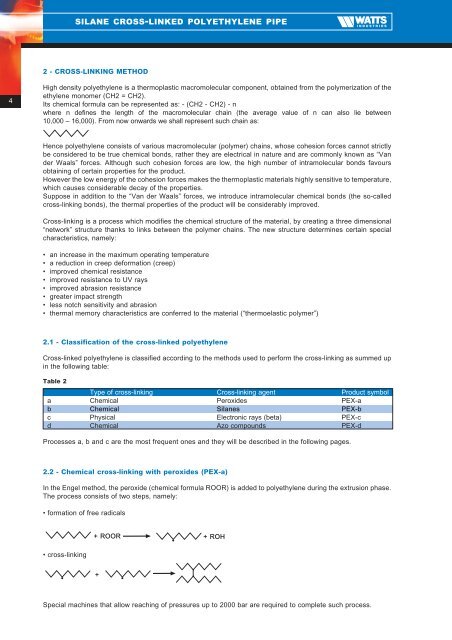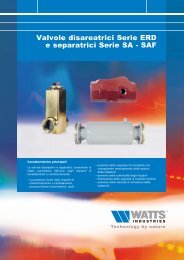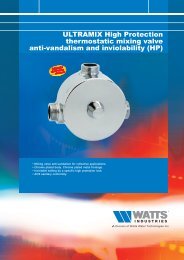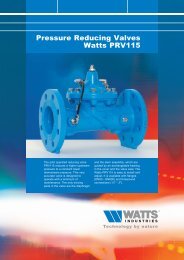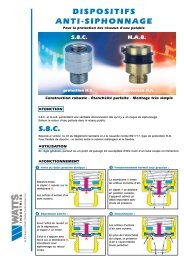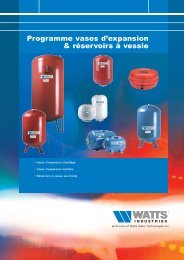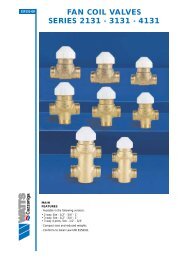Silane cross-linked polyethylene pipe INTERSOL ... - Watts Industries
Silane cross-linked polyethylene pipe INTERSOL ... - Watts Industries
Silane cross-linked polyethylene pipe INTERSOL ... - Watts Industries
You also want an ePaper? Increase the reach of your titles
YUMPU automatically turns print PDFs into web optimized ePapers that Google loves.
SILANE CROSS-LINKED POLYETHYLENE PIPE<br />
2 - CROSS-LINKING METHOD<br />
4<br />
High density <strong>polyethylene</strong> is a thermoplastic macromolecular component, obtained from the polymerization of the<br />
ethylene monomer (CH2 = CH2).<br />
Its chemical formula can be represented as: - (CH2 - CH2) - n<br />
where n defines the length of the macromolecular chain (the average value of n can also lie between<br />
10,000 – 16,000). From now onwards we shall represent such chain as:<br />
Hence <strong>polyethylene</strong> consists of various macromolecular (polymer) chains, whose cohesion forces cannot strictly<br />
be considered to be true chemical bonds, rather they are electrical in nature and are commonly known as “Van<br />
der Waals” forces. Although such cohesion forces are low, the high number of intramolecular bonds favours<br />
obtaining of certain properties for the product.<br />
However the low energy of the cohesion forces makes the thermoplastic materials highly sensitive to temperature,<br />
which causes considerable decay of the properties.<br />
Suppose in addition to the “Van der Waals” forces, we introduce intramolecular chemical bonds (the so-called<br />
<strong>cross</strong>-linking bonds), the thermal properties of the product will be considerably improved.<br />
Cross-linking is a process which modifies the chemical structure of the material, by creating a three dimensional<br />
“network” structure thanks to links between the polymer chains. The new structure determines certain special<br />
characteristics, namely:<br />
• an increase in the maximum operating temperature<br />
• a reduction in creep deformation (creep)<br />
• improved chemical resistance<br />
• improved resistance to UV rays<br />
• improved abrasion resistance<br />
• greater impact strength<br />
• less notch sensitivity and abrasion<br />
• thermal memory characteristics are conferred to the material (“thermoelastic polymer”)<br />
2.1 - Classification of the <strong>cross</strong>-<strong>linked</strong> <strong>polyethylene</strong><br />
Cross-<strong>linked</strong> <strong>polyethylene</strong> is classified according to the methods used to perform the <strong>cross</strong>-linking as summed up<br />
in the following table:<br />
Table 2<br />
Type of <strong>cross</strong>-linking Cross-linking agent Product symbol<br />
a Chemical Peroxides PEX-a<br />
b Chemical <strong>Silane</strong>s PEX-b<br />
c Physical Electronic rays (beta) PEX-c<br />
d Chemical Azo compounds PEX-d<br />
Processes a, b and c are the most frequent ones and they will be described in the following pages.<br />
2.2 - Chemical <strong>cross</strong>-linking with peroxides (PEX-a)<br />
In the Engel method, the peroxide (chemical formula ROOR) is added to <strong>polyethylene</strong> during the extrusion phase.<br />
The process consists of two steps, namely:<br />
• formation of free radicals<br />
• <strong>cross</strong>-linking<br />
+ ROOR + ROH<br />
+<br />
Special machines that allow reaching of pressures up to 2000 bar are required to complete such process.


